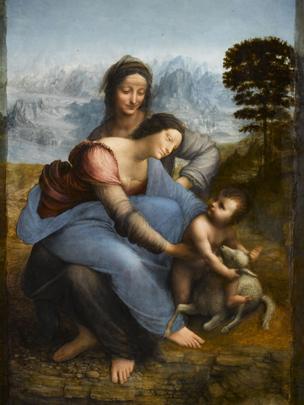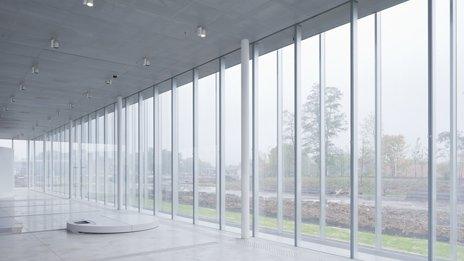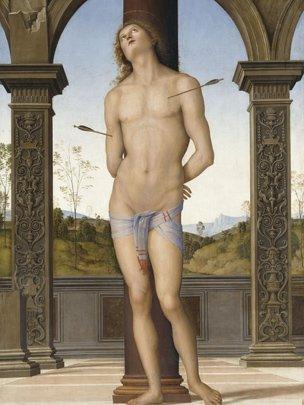Louvre opens new wing in the north
- Published
An offshoot of the Louvre to open in northern France
This week, one of the world's best-known museums opens a new outpost in a former mining town in northern France. But what's in its shiny new galleries?
It's almost a decade since France's then Prime Minister Jean-Pierre Raffarin decided the treasures of the Louvre should no longer be reserved only for Parisians and tourists: The museum's magnificent collection needed to be seen around the country.
The location eventually chosen for the Louvre's little brother, against competition from the likes of Boulogne and Amiens, was Lens.
The president of the Louvre is Henri Loyrette. He admits that even in France many people barely know where Lens is. "But I am certain Lens is exactly the right place for us to come.
"The savoir-faire of the Louvre is for the whole nation - but it's something we forgot in the nineteenth and twentieth centuries."

Leonardo da Vinci's newly restored The Virgin and Child with Saint Anne is on display for the opening
Two years ago, Paris's Pompidou Centre opened a big new branch at Metz in eastern France. The Louvre is now following suit but Loyrette says the choice of Lens is much more ambitious.
"This city was destroyed twice - in the First World War and then when coal-mining ended from the 1960s onward.
"To have gone somewhere like Aix-en-Provence, somewhere with obvious tourist appeal, would have been meaningless. This is a huge departure for us."
Lens currently has little to attract visitors: Even hotel accommodation is sparse. But its location, which made it a target in wartime, may now be an asset.
Lens is 75 minutes from Paris by TGV and 50 kilometres from the Belgian border. The museum's plans assume thousands of visitors will come from Belgium and the Netherlands, as well as from Germany and Britain.
The new gallery has been designed by Pritzker Prize-winning architects SANAA (Sejima & Nishizawa and Associates).
The silvery grey one-storey buildings will surprise some with their simplicity. They wouldn't look out of place on a modern university campus and couldn't be less like the original Louvre in Paris.
The overall cost is around £125m - with a lot of the cash spent on creating a spacious new park to surround the buildings and link them to the slightly down-at-heel city centre.
Loyrette says the designs don't strive for the "wow factor" of Frank Gehry's Guggenheim Bilbao in Spain 15 years ago.
"But, you know, I am very happy with simpler buildings. We now have so many architectural gestures sometimes it's hard even to hang a picture. In Lens we have a museum with walls and skylights - it's exactly what I wanted."
The museum's 125-metre long permanent space, La Galerie du Temps, includes around 200 items selected from the Louvre in Paris. Loyrette insists there's no question of the Louvre quietly clearing out store-rooms and sending second-rate material to Lens. "On the contrary - there are only masterpieces."
The gallery walls are aluminium and, unusually for an art museum, reflections abound.

The gallery's open, airy architecture recalls the Louvre Pyramid more than the wings and pavilions of the "old Louvre"
For now the centrepiece of Louvre-Lens is probably 'Liberty Leading the People' - Delacroix's celebrated painting of 1830. Alongside it hangs an Ingres portrait of Louis-Francois Bertin.
In Lens, the Louvre is taking a new approach to its displays, which Loyrette terms "transversal".

Works from across the centuries will hang together in one, long gallery, including Perugino's Saint Sebastien
"It is not like Paris, where most material is in chronological or geographical sections. In the main gallery we bring together paintings and sculpture from the ancient world to the nineteenth century."
As well as the permanent display there will be big temporary exhibitions - the first focuses on the Renaissance, with Rubens to follow. The idea is both to attract new museum-goers and to get visitors familiar with the Louvre in Paris to take a fresh look at familiar objects.
In time, almost anything in the Louvre could make the trip up to Lens to stay months or even years. The exception is the Leonardo Mona Lisa which, due to its delicacy, seems unlikely ever to leave Paris.
Though formally opened this week, the general public will be allowed through the doors from 12 December. The extra few days may help in sorting out the surrounding park areas, which remained something of a morass even as VIPs turned up for the inauguration.
Louvre-Lens is expecting 500,000 visitors a year compared to around 9 million annually in Paris. To begin with, the permanent collection will be free to visit.
Daniel Percheron, president of the Nord-Pas de Calais region, sees a political aspect to the opening.
"This was once a huge mining area but the industry died. The whole place was just abandoned by a nation whose priorities were elsewhere.
"So the Louvre coming here now is kind of a recompense for that."
- Published5 December 2012
- Published21 September 2012
- Published23 March 2012